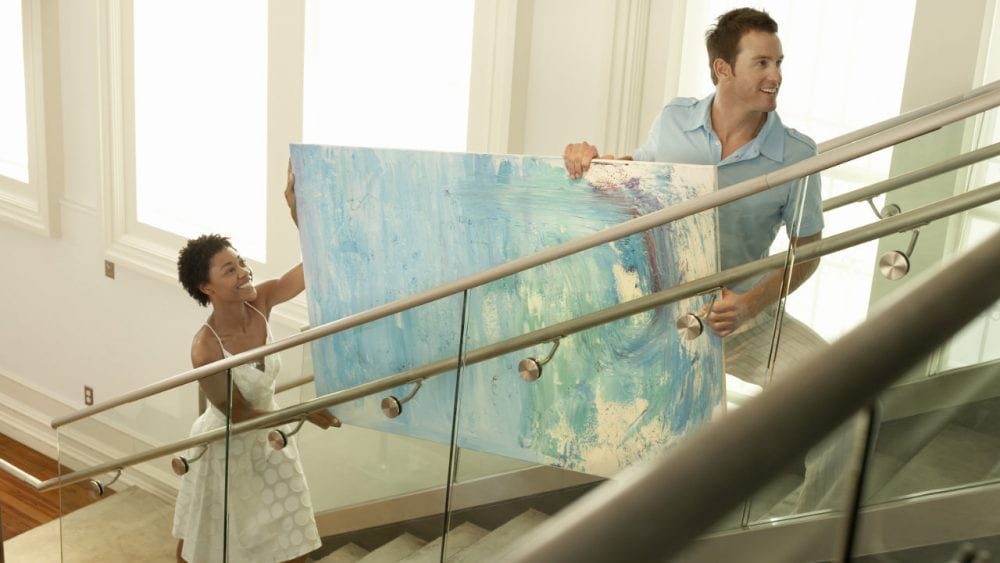Purchasing art is only the first step in building and maintaining an art collection. Proper handling, framing, display and preservation are key to ensure your work remains in good condition in the long term.
Insurance
At the purchasing stage, make sure to keep any documentation, invoices, proof of export or certificates of authenticity. Certificates should be cared for as vital addendums to the artwork themselves, particularly in the case of prints. Some prints will not be signed, titled, dated or numbered on the sheet itself, so the certificate of authenticity is an essential record in authenticating the work. In some instances, without the accompanying certificate, the work would be difficult to sell in the future.
For works over a certain value, a collector may need to notify their insurer. Some insurers will name high-value works specifically on the insurance plan, protecting them up to an agreed amount and specifying certain security criteria for the insurance to be valid. Importantly, many insurers have criteria for stored works to be insured as well. Often works need to be kept a certain height off the ground, behind locked and secure doors, and away from potential flood risks.
Shipping
If you don’t physically carry a purchased artwork away from the gallery with you, it will likely be sent to you, whether by mail or art carrier. There are various reputable art carriers that have specialised knowledge in how to best pack, transport and install artworks and procure the correct export licences and paperwork required for onward travel. Larger galleries and most museums will use these carriers, but some smaller galleries and independent artists may pack and send artworks themselves via FedEx, Parcelforce etc.
Should you or the gallery choose to send artwork via an art carrier, your work may travel card packed in a travel frame or crated. When an artwork is card packed, it usually is wrapped in glassine or tyvek, then wrapped in cardboard and sealed (imagine an Amazon cardboard package, but much sturdier and cut to fit the artwork like a glove). This is the least expensive option but is really only suitable for framed artworks or canvases without friable edges or heavy impasto.
A travel frame is a mid-range option: it usually has a cardboard back and slats at the front. The artwork will be mirror-plated (attached with screws) to the inside of the travel frame; clear polythene will be stretched across the travel frame, stapled along the sides, and then the ‘batons’ are screwed to the front to protect anything from piercing the polythene. These travel frames can be made any size but particularly suit larger works. For very valuable works, travel frames can travel within crates for even more security.
Travel frame
Crates are the top of the range shipping option but the most expensive. Works can be in card packs or travel frames within a crate, and crates can have tilt monitors installed to show if the work has been tipped over (if it is meant to travel upright). For extremely high-value works, you can have climate-controlled crates (common for museum loans). As seen in the image below, crates will usually have arrows indicating which way is up or whether they should travel flat.
Packing and Storage
If you do not intend to install your artwork immediately, and it arrived packed in a card pack, travel frame or crate, this is a wonderful way to keep your artwork safe while it is in storage.
Otherwise, if you need to pack your artworks for short-term storage, there are few solutions.
For sculptures or ceramics, if the edges are not fragile and there are no loose and potentially breakable parts, you can pack them into card boxes surrounded by acid-free tissue paper. If wrapping the works in tissue isn’t possible because the tissue would catch on and or damage the work, you can put them in foam-lined cardboard boxes instead.
For canvases, the best wrapping materials are Tyvek and glassine, followed by acid-free tissue. Tissue is the least advisable because if the paint is even slightly tacky, you can end up with tissue stuck to the surface of the painting. If this happens, a conservator may be able to remove the tissue (or the more enterprising may attempt this themselves with a very slightly damp cotton ear bud rubbed slowly across the tissue). Once wrapped, canvases can be card packed for additional protection.
Framed works can be wrapped in bubble wrap (bubble side out) or card packed. If the work is framed under glass, glass tape can be used to protect the glass. Glass tape should not be used on UV (museum glass) or perspex!
Prints should be stored flat where at all possible. There’s a tendency for people to roll prints to maximise storage space, but leaving prints rolled for a long period of time puts pressure on the fibres in the paper. If you need to roll a print for a short period of time, make sure to lay acid-free tissue below and on top of the print, and roll along the long edge with the printed surface up. The larger the tube, the better because you need to roll the print less tightly. When storing a print flat, you can store them in acid-free sleeves, in acid-free tissue sandwiched between two pieces of card, or in acid-free tissue in a plan chest.
Framing
Where possible, it is certainly advisable to take your artworks to a professional framer to have them framed to a high standard. A framer can advise the best mounting technique for your piece and ensure that it is done in the least invasive way.
There are several considerations when making framing decisions. You generally have a work mounted in two ways:
- Float mounted (essentially stuck to a board, which will come in various thicknesses and colours). In this method, the edges of the print or artwork are visible.
- Window mounted (an aperture is cut in a mount-board, and the artwork is placed behind it). In this method, the artwork will typically sit between the window mount and backing board, and will be affixed to the rear of the window mount or to the backing board. This is a good method when the edges of the work are unsightly, or when there is an inscription on the reverse of the work that you want to keep pristine.
Framers must use preservation grade materials in this process. The mount boards should be acid-free, and archival hinging tape should be used so the work can be easily removed or reframed later.
Another consideration is glazing – whether to have glass, perspex, museum glass or nothing at all. Typically you won’t utilize glazing (glass, perspex, or museum glass) for framed works in a domestic setting – both because it interferes with seeing the surface of the work and makes the frame much heavier. There are some instances, particularly where the work is very susceptible to dust settling, moisture damage or light damage, that you may choose to do so. Museum glass will filter UV rays, so while it is more expensive, it is a good option for works you do not want to see the fade in sunlight.
Hanging
There are various ways of hanging art – ranging from the simple to the very secure. For very light and small works, a straightforward picture hanging kit will do the trick.
For anything larger or heavier, the best practice is to put D rings on the back of the work or frame and hang the D rings over two screws (with wall plugs). While picture wire is a fast and easy way of levelling off a picture, it is not very secure (can easily snap or wear down over time), so it should be avoided.
For really heavy artwork, you can hang from straphangers. Two screws should be put in the wall (with wall plugs), and two straphangers should be affixed to the back of the work, then hung on the screws.
For any high-value works that you are particularly worried about, you can use security fixings. These come in two parts, one fixed to the back of either side of the work. You hang the work on these fixings on two screws, then slide in the locking spring. The kit comes with a key that you can use to release the spring, but without the key, the work stays firmly in place, even if you try to tug it off the wall.
Lighting
Lighting is a tricky concept in displaying art; proper lighting can transform art, but high light levels can irrevocably damage artworks. In general, direct light is not advisable without UV glass to protect the work. Otherwise, spotlighting is a good way to light from above and adjust when new works are added. You can find various track lighting kits online that allow you to spotlight artworks in a room.
For those with more traditional lighting tastes, you can install picture lights over each artwork. There are various options, from the more traditional brass ones you see in museums to contemporary ones in various colours.




